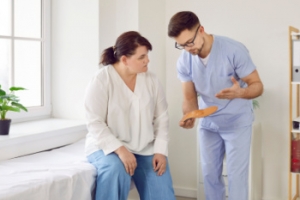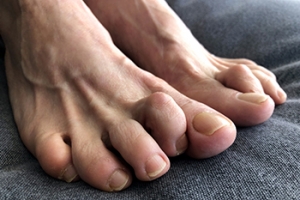
Learning About Biomechanics of the Feet
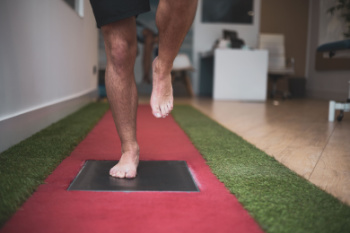
Your feet and ankles are very important for how you move. Imagine them like the strong base of a building. They help you stand up straight and walk around without falling over. But did you know they do even more? They also help you push against things when you move. For instance, you push against the ground when you run or jump. But if your feet and ankles don't move the right way, it can cause problems. You might feel pain or get hurt. The muscles, bones, ligaments, and tendons in your feet and ankles all work together to keep you safe and moving. Learning about how your feet and ankles work helps you understand why they're so special and how we can take care of them. If you would like to learn more about how the feet and ankles work together to support your body or you have sustained an injury to these parts of your lower extremities, it is suggested that you make an appointment with a podiatrist for treatment.
If you have any concerns about your feet, contact Dr. Thomas E. Silver from Westwood Foot Clinic. Our doctor can provide the care you need to keep you pain-free and on your feet.
Biomechanics in Podiatry
Podiatric biomechanics is a particular sector of specialty podiatry with licensed practitioners who are trained to diagnose and treat conditions affecting the foot, ankle and lower leg. Biomechanics deals with the forces that act against the body, causing an interference with the biological structures. It focuses on the movement of the ankle, the foot and the forces that interact with them.
A History of Biomechanics
- Biomechanics dates back to the BC era in Egypt where evidence of professional foot care has been recorded.
- In 1974, biomechanics gained a higher profile from the studies of Merton Root, who claimed that by changing or controlling the forces between the ankle and the foot, corrections or conditions could be implemented to gain strength and coordination in the area.
Modern technological improvements are based on past theories and therapeutic processes that provide a better understanding of podiatric concepts for biomechanics. Computers can provide accurate information about the forces and patterns of the feet and lower legs.
Understanding biomechanics of the feet can help improve and eliminate pain, stopping further stress to the foot.
If you have any questions please feel free to contact our office located in Golden Valley, MN . We offer the newest diagnostic and treatment technologies for all your foot and ankle needs.
Biomechanics in Podiatry
Podiatry is a branch of medicine that deals with the study, diagnosis, and treatment of foot and ankle conditions. There are various subdivisions in podiatry; biomechanics is one of them. Biomechanics is the way in which the bones, muscles, and joints of the feet and lower limb interact with each other.
Our feet play crucial roles in the way we move, and it is rare to have feet that are completely symmetrical. Common biomechanical issues include high or low arches or uneven leg heights. Excessive pronation often leads to fallen arches, or flat feet, and is a common cause of running injuries. People whose feet are over-pronated tend to have flexible and unstable feet. Pain is usually experienced during walking and running.
At times, people may be able to adapt to these abnormalities without any difficulties, but in other cases, these issues can cause a great deal of pain. This pain occurs because the joints, muscles, ligaments, and tendons are put under an excess amount of stress during movement. Common symptoms of biomechanical problems stemming from the feet include hip pain, knee pain, leg cramps, ankle pain, lower back pain, weak ankles, tripping, heel pain, Achilles pain, and shin splints.
Many biomechanical issues can be treated with orthotics. Orthotics are shoe insoles that are used to help control the way the foot operates. They can provide relief from foot pain, heel pain, and knee pain. Depending on your specific case, you may need to purchase over-the-counter orthotics or custom orthotics to fit your feet. Your podiatrist will be able to prescribe the perfect orthotic for your feet to help you walk around with ease.
Gait is defined as the way we move our bodies from one point to another. This is usually done by either walking or running. Gait analysis is a method used to assess the way we walk or run to highlight biomechanical abnormalities. Gait analyses are a great way to take a detailed look at how you walk and how your foot moves while you walk. An examination of the feet will help your podiatrist understand why you are suffering pain in other parts of your body.
Ankle Joint Replacement Surgery
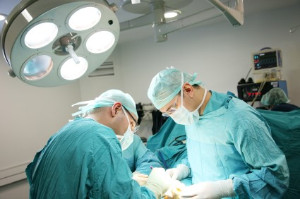
Total ankle replacement is a surgical procedure that can be performed by podiatrists to address ankle arthritis, whether it stems from aging or injury. This intervention involves replacing the damaged ankle joint with a synthetic implant made of metal and plastic, with the goal of relieving pain and restoring mobility. Unlike ankle fusion surgery, total ankle joint replacement aims to preserve joint motion. Candidates for this procedure typically include patients who have tried and failed non-surgical treatments and continue to experience persistent ankle pain and functional limitations. However, certain factors, such as severe deformity or compromised bone integrity, may influence treatment decisions. Recovery from total ankle replacement involves a period of non-weight bearing, followed by gradual rehabilitation. The ankle replacement procedure carries risks like infection and implant failure, that a podiatrist can help manage. If you are suffering from ankle arthritis and exploring treatment options, it is suggested that you consult with a podiatrist to discuss whether total ankle replacement may be the right choice for you.
In certain cases, in which the patient suffers from extreme pain or damage in a joint, joint replacement surgery may be deemed useful. If you have constant pain in a foot joint, consult with Dr. Thomas E. Silver from Westwood Foot Clinic. Our doctor will assess your condition and provide you with quality foot and ankle treatment.
What Is Joint Replacement Surgery?
Over time, joints wear down; this can be exacerbated by diseases and conditions. Joint replacement surgery, also known as arthroplasty, is when a damaged joint is surgically removed and replaced with a prosthesis. Prostheses, which can be made of ceramic, plastic, or metal, act as joints in lieu of an actual joint. One of the most prevalent causes for joint replacement is arthritis.
Arthritis in the Foot
Arthritis can occur in any joint in the body, including in the feet. Common types of arthritis in the foot are osteoarthritis, rheumatoid arthritis, and gout. The big toe is usually where arthritis occurs in the foot; this is known as hallux rigidus.
Joint Replacement Surgery in the Foot
The most common form of joint replacement in the foot is a first metatarsophalangeal (MTP) joint placement. MTP joint replacement surgery is designed to treat hallux rigidus. Surgery is not intensive, and recovery occurs within one to two months after the procedure has been done. Overall, joint replacement surgery is a safe and effective way to treat pain in the joint of the foot.
If you have any questions, please feel free to contact our office located in Golden Valley, MN . We offer the newest diagnostic and treatment technologies for all your foot care needs.
Joint Replacement Surgery
When conservative, noninvasive treatments prove unsuccessful, podiatrists will often turn to surgery as the last line of treatment for their patients. If patients are suffering from joint pain, issues in mobility, or are seeking to correct a deformity, joint replacement surgery is an effective option. Joint replacement surgery is also successful in treating arthritis, which is the most common cause of improperly working joints.
Patients with symptoms that include joint pain, stiffness, limping, muscle weakness, limited motion, and swelling are typically considered for joint replacement surgery. Range of motion and activity post-surgery will vary between patients and depending on the specific surgery performed, the affected joint, and the damage that will need to be repaired.
Joint replacement surgery replaces the damaged cartilage and bone, the latter if required. The damaged cartilage is typically replaced with a prosthesis that is attached to the bone, allowing the implant to grow into the bone. Following surgery, the patient will typically undergo physical therapy to become familiar with movement using the replaced joint.
The Importance of Wearing Properly Fitting Shoes
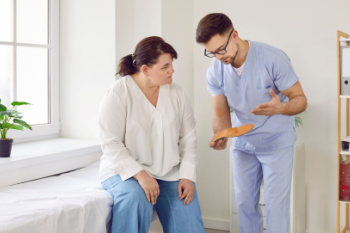
In our modern world dominated by concrete and cement, the demise of shoes seems unlikely. This reliance, however, has led to chronic back and foot pain. Podiatrists play an important role in addressing these issues. Wearing improper or ill-fitting shoes can lead to various problems, from bunions to muscle tension and even plantar fasciitis. Choosing the right shoes involves considering factors like foot swelling throughout the day and ensuring proper fit and support. Additionally, rotating shoes to engage different muscles and replacing worn out ones are important practices. A podiatrist can offer personalized advice and treatments to alleviate foot pain and prevent future issues, emphasizing the importance of footwear in maintaining healthy and pain-free feet. If you would like guidance in making sure you get the right sized shoes that fit your feet well, it is suggested that you schedule an appointment with a podiatrist for a consultation.
Getting the right shoe size is an important part of proper foot health. Seek the assistance of Dr. Thomas E. Silver from Westwood Foot Clinic. Our doctor will provide the care you need to keep you pain-free and on your feet.
Getting the Right Shoe Size
There are many people who wear shoes that are the incorrect size, negatively affecting their feet and posture. Selecting the right shoes is not a difficult process, so long as you keep several things in mind when it comes to choosing the right pair.
- When visiting the shoe store, use the tools available to measure your foot.
- Be sure there is ‘wiggle room’. There should be about an inch between your toes and the tip of your shoes.
- Do not always assume you are the same size, as manufacturers run differently.
- Purchase shoes later in the day, as your feet swell as the day progresses.
- If a shoe is not comfortable, it is not suitable. Most shoes can’t be ‘broken in’, and comfort should be the ultimate goal when it comes to choosing the right pair of shoes
As our feet hold our body weight and keep us moving, it is important to treat them right. Picking the right pair of shoes can provide your feet comfort and mobility without pain.
If you have any questions, please feel free to contact our office located in Golden Valley, MN . We offer the newest diagnostic and treatment technologies for all your foot care needs.
Getting the Right Shoe Size: To Keep Your Feet Happy
People are constantly wearing improperly-fitting shoes. Though it isn’t hard, picking the right shoes does require keeping a few things in mind.
Shoe stores have rulers so you can get an exact measurement of your feet. Be sure to always measure your feet with your shoes on. Measuring just your foot will give you a shoe size that is 1-2 inches too small for picking the right size shoe.
To ensure that your toes won’t be cramped, make sure there is wiggle room. Approximately one inch should be between your toes and the tip of your shoe. It is easy to tell if your shoes are too tight, because you will start to experience pain, blisters, and swelling.
Additionally, do not always assume your shoe size will be the same at every store. Manufacturers sometimes run differently, and your size will vary from brand to brand. Make sure the stores you purchase from have return policies, in case there is a problem.
Rather than shoe shopping in the morning, it is advised to shop for shoes later in the day. Your feet will swell as the day passes. If shoes are purchased in the morning, they may not be as snug as they should be. Furthermore, not all two feet are the same size. Therefore, accommodations may be necessary.
An overall concern in buying shoes is making sure they are comfortable and supportive. There is no such thing as a shoe being ‘broken in’. If they are uncomfortable at the store, they likely will always be uncomfortable.
Since we do a lot of walking, it is important that we pick the right shoes. Our feet will benefit from this, and we will be happier and healthier because of it.
Why Foot Corns Develop in Certain Spots
 Corns can develop on many parts of the feet, although certain areas are more prone to corn formation due to increased pressure, friction, or rubbing against footwear. One common location for corns is on the tops of the toes, particularly over joints where the toe bones meet. The pressure from shoes that are too tight or narrow can cause friction in these areas. Similarly, corns may form on the sides of the toes, where adjacent toes rub against each other or against the sides of shoes. On the soles of the feet, corns often occur over bony prominences, such as the balls of the feet or the heels. Excessive pressure from walking or standing can cause thickened areas of skin to develop. Soft corns can also form between the toes due to moisture accumulation and friction. If you have corns on your feet, it is suggested you consult with a podiatrist who can provide more information about effective treatment and prevention.
Corns can develop on many parts of the feet, although certain areas are more prone to corn formation due to increased pressure, friction, or rubbing against footwear. One common location for corns is on the tops of the toes, particularly over joints where the toe bones meet. The pressure from shoes that are too tight or narrow can cause friction in these areas. Similarly, corns may form on the sides of the toes, where adjacent toes rub against each other or against the sides of shoes. On the soles of the feet, corns often occur over bony prominences, such as the balls of the feet or the heels. Excessive pressure from walking or standing can cause thickened areas of skin to develop. Soft corns can also form between the toes due to moisture accumulation and friction. If you have corns on your feet, it is suggested you consult with a podiatrist who can provide more information about effective treatment and prevention.
Corns can make walking very painful and should be treated immediately. If you have questions regarding your feet and ankles, contact Dr. Thomas E. Silver of Westwood Foot Clinic. Our doctor will treat your foot and ankle needs.
Corns: What Are They? And How Do You Get Rid of Them?
Corns are thickened areas on the skin that can become painful. They are caused by excessive pressure and friction on the skin. Corns press into the deeper layers of the skin and are usually round in shape.
Ways to Prevent Corns
There are many ways to get rid of painful corns such as:
- Wearing properly fitting shoes that have been measured by a professional
- Wearing shoes that are not sharply pointed or have high heels
- Wearing only shoes that offer support
Treating Corns
Although most corns slowly disappear when the friction or pressure stops, this isn’t always the case. Consult with your podiatrist to determine the best treatment option for your case of corns.
If you have any questions please feel free to contact our office located in Golden Valley, MN . We offer the newest diagnostic and treatment technologies for all your foot and ankle needs.
Corns and Calluses
A corn is a lesion that forms in the skin of the foot, and it is typically circular in shape, small in size, and thick and rough in texture. A corn generally occurs as a result of repeated pressure on the skin; one example of this is the rubbing of a shoe against the skin. Corns differ from calluses in that their central cores are harder in texture.
A corn is a relatively common condition with a wide variety of treatment options. If a corn becomes overly uncomfortable or painful, consult with your podiatrist; he can determine the best method of treatment that is appropriate for you. Corns may return if the underlying cause of its development is not treated or removed. Avoid removing corns at home, as improper removal may cause infection.
A callus, similar to a corn, is an area of skin that has become thickened due to repeated pressure and rubbing. The rubbing causes the skin to create a layer of protective skin, which is the formed callus. Calluses can differ in size between people, and they can also become painful.
Multiple treatments are available for calluses. At-home treatment and removal should be avoided, as this can potentially lead to infection. Your podiatrist can best determine the cause of your calluses and suggest the treatment most appropriate for you.
Hammertoe Symptoms
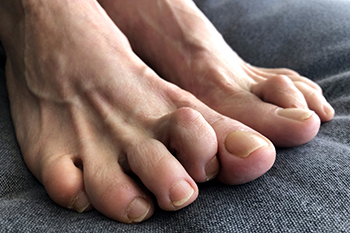
Daily wear and tear can harm your toes, which are essential for balance and movement. Hammertoe is a toe problem where the middle joint bends upward, making the toe look like a hammer. Toes have muscles on top to stretch them and muscles underneath to bend them. Weak bottom muscles can lead to an upward bend at the middle joint, causing a hammertoe. This can hurt while walking and may affect balance. Symptoms include a bent toe that will not relax, swelling, corns, calluses, pain while walking, and changes in balance or walking style. Other toe issues like claw toes, mallet toes, and bunions exist, often alongside hammertoes. Risk factors include foot shape, medical conditions, like diabetes, arthritis, wrong shoes, and foot injuries. If you have a hammertoe that is causing discomfort, it is suggested that you schedule an appointment with a podiatrist for guidance.
Hammertoes can be a painful condition to live with. For more information, contact Dr. Thomas E. Silver of Westwood Foot Clinic. Our doctor will answer any of your foot- and ankle-related questions.
Hammertoe
Hammertoe is a foot deformity that occurs due to an imbalance in the muscles, tendons, or ligaments that normally hold the toe straight. It can be caused by the type of shoes you wear, your foot structure, trauma, and certain disease processes.
Symptoms
- Painful and/or difficult toe movement
- Swelling
- Joint stiffness
- Calluses/Corns
- Physical deformity
Risk Factors
- Age – The risk of hammertoe increases with age
- Sex – Women are more likely to have hammertoe compared to men
- Toe Length – You are more likely to develop hammertoe if your second toe is longer than your big toe
- Certain Diseases – Arthritis and diabetes may make you more likely to develop hammertoe
Treatment
If you have hammertoe, you should change into a more comfortable shoe that provides enough room for your toes. Exercises such as picking up marbles may strengthen and stretch your toe muscles. Nevertheless, it is important to seek assistance from a podiatrist in order to determine the severity of your hammertoe and see which treatment option will work best for you.
If you have any questions, please feel free to contact our office located in Golden Valley, MN . We offer the newest diagnostic and treatment technologies for all your foot care needs.




